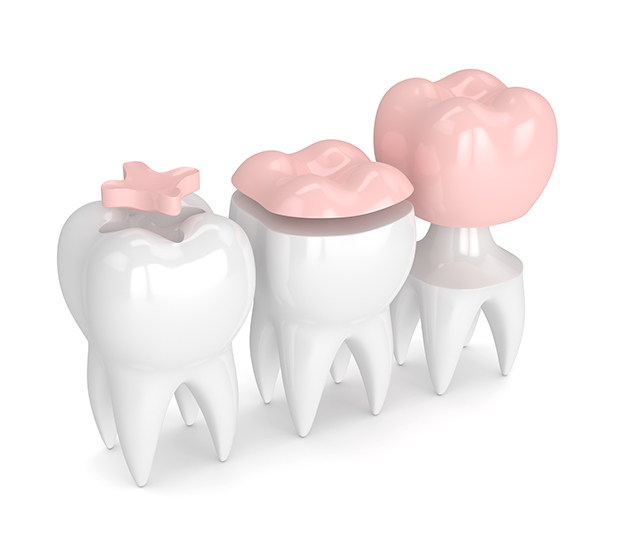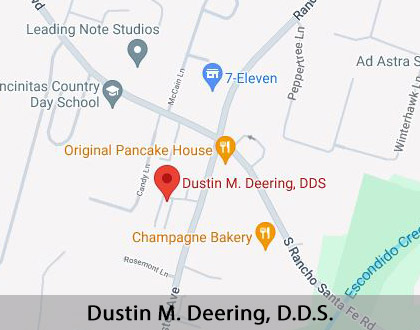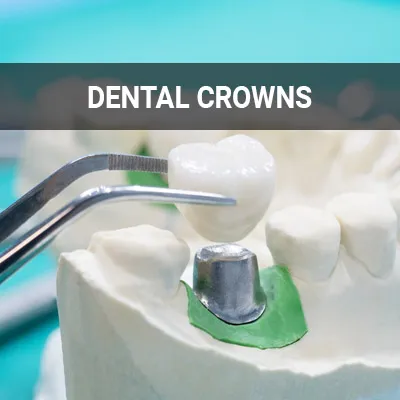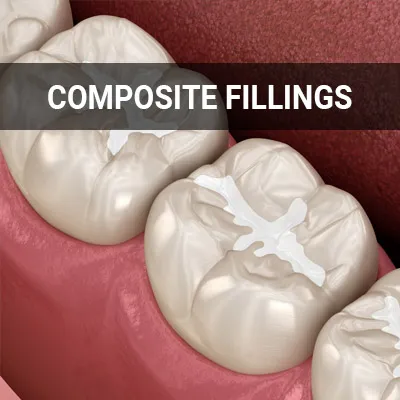Dental Inlays and Onlays in Encinitas
If you're looking to upgrade old metal fillings or restore a damaged tooth with a more natural appearance, dental inlays and onlays may be the ideal solution. At the office of Dr. Deering in Encinitas, we offer custom-crafted, tooth-colored inlays and onlays designed to blend seamlessly with your smile—offering both strength and beauty.
Unlike traditional silver or gold fillings, modern inlays and onlays are made from durable, aesthetic materials such as porcelain or composite resin. These restorations are precisely designed to fit the shape of your tooth, either nestled within the cusps (inlay) or extending over one or more cusps (onlay), depending on the extent of the damage.
Inlays and onlays are available at Dustin Deering, DDS in Encinitas and the surrounding area. Our staff can help you determine whether this treatment is right for you. Call us at (760) 753-9036 to schedule an appointment.
Why Choose Inlays and Onlays?
Aesthetic Upgrade: Replaces old, visible metal fillings with natural-looking materials
Durable Solution: Stronger and longer-lasting than standard fillings
Comfortable Fit: Custom-made for a perfect, functional bite
Durable Solution: Stronger and longer-lasting than standard fillings
Stain-Resistant: Maintains a clean, bright appearance over time
Most patients who receive inlays or onlays have already had their cavity treated, making the process smoother and more comfortable. With Dr. Deering’s gentle approach and attention to detail, treatment is typically quick, pain-free, and completed in just two visits.
Schedule Your Consultation
Whether you're looking to replace old fillings or repair a damaged tooth, Dr. Deering and his team in Encinitas are here to help restore your smile with confidence. Call us today at (760) 753-9036 to schedule a consultation and learn if inlays or onlays are right for you.
The process of inlays and onlays both involve bonding material to attach and seal it to the tooth. In both treatments, the bonding material may actually improve the strength of the tooth.
What are Inlays and Onlays?
Inlays
Traditionally, inlays replace a small amount of tooth structure left by a cavity, just as fillings do. They filled and sealed the tooth but were made only of gold. Inlays today are made of tooth-colored material such as ceramic, porcelain, or a specialized dental composite.
The inlay consists of the tooth-colored material and bonding, a clear fluid material, to attach the inlay to the tooth. As explained by the American College of Prosthodontists, "Using a clear fluid version of this material to seal the exposed surfaces of the teeth decreases sensitivity to temperature changes and certain types of foods." The bonding material is also tooth-colored and may help improve the color and appearance of stained or discolored teeth.
Onlays
Onlays are similar to inlays in that they fill a missing hole caused by a cavity, but onlays extend onto the chewing surface of a tooth to replace one or more cusps. Traditionally, they were also only made of gold, but tooth-colored onlays have made an appearance in dentistry. An onlay is considered a more effective option for patients with large cavities or the decayed area expands over the top of the tooth.
The process of inlays and onlays both involve bonding material to attach and seal it to the tooth. In both treatments, the bonding material may actually improve the strength of the tooth.
"An onlay is considered a more effective option for patients who have large cavities or the decayed area expands over the top of the tooth."
Inlay or Filling– Which Is Right for You?
When restoring a tooth affected by decay, patients today often have the option to choose between a traditional filling and a custom inlay. Inlays are a cosmetic and durable alternative that can replace old metal fillings while offering a more natural, seamless appearance. At Dr. Deering’s practice in Encinitas, we take precise impressions of the affected tooth to create an inlay that fits perfectly—matching the exact shape and size of the cavity. This custom fit allows the inlay to reinforce and strengthen the tooth, unlike some fillings that may weaken the surrounding structure over time.
Thanks to their superior aesthetics and long-lasting durability, inlays have become an increasingly popular choice among patients. While traditional fillings are still occasionally used—especially in cases where a patient has an allergy or sensitivity to certain materials—Dr. Deering will recommend the most appropriate solution for your comfort, oral health, and smile goals.
"Inlays are formulated using an impression of the cavity and are fabricated to the exact size and shape of the cavity as opposed to being filled in."
Onlay vs. Crown
An onlay is generally used when a patient has a small hole that is only a tad larger than an inlay or old filling. In most cases, an onlay can cover the cavity hole and surrounding area. Onlays are a less aggressive restoration treatment than crowns as a smaller amount of tooth structure needs to be removed.
On the other hand, crowns are caps or covers used to restore the function and appearance of a tooth but replace the tooth itself. Crowns are indicated for teeth with very large fillings, teeth that have had a root canal, fractured teeth, worn teeth due to grinding, and misshapen and/or discolored teeth. The key distinguishing factor Dr. Deering will use to determine the right choice for a patient is the size of the cavity.
"The key distinguishing factor Dr. Deering will use to determine the right choice for a patient is the size of the cavity."
Check out what others are saying about our dental services on Yelp: Dental Inlays and Onlays in Encinitas, CA
Benefits of Inlays and Onlays
Inlays
The key benefits of inlays lie in their durability and strength. They are intended to protect and seal the tooth from further damage using cemented material custom-fit to each tooth. The sealed inlays also protect the tooth from air and food particles from entering the tooth, which causes a sensitive sensation. Inlays promote better long term periodontal health because they typically have better and more custom contours than a filling that is directly placed in the mouth. Inlays are more stable and stay in your tooth for much longer than a filling with proper oral care.
Onlays
Onlays have much of the same benefits as inlays. An added benefit to onlays is they can save much of the patient's tooth structure and provide additional strength and support for the affected tooth. Crowns require treatment and typically involve removing the entire tooth, or at minimum, much of the tooth structure. Onlays are also custom-fit for each patient and use stain-resistant material, making them last much longer without affecting appearance.
"Inlays are more stable and stay in your tooth for much longer than a filling with proper oral care."
Questions Answered on This Page
Q. What is the difference between an inlay and an onlay?
Q. Should I get an inlay or a filling?
Q. Should I get an onlay or a crown?
Q. What are the key benefits of inlays and onlays?
People Also Ask
Q. What are composite fillings?
Q. How can cosmetic dentistry restore teeth?
Q. How can a person's diet help with tooth decay?
Q. How do lifestyle choices affect dental health?
Q. What should patients do if they have sensitive teeth?
Q. How can someone find out what procedures their dental insurance covers?
Understanding the Differences: Inlays, Onlays, and Veneers
When it comes to restoring or enhancing your smile, it's important to understand the distinct roles of inlays, onlays, and veneers—each serves a different purpose in dental care.
Veneers are thin, custom-made shells designed to cover the front surface of teeth. They are primarily cosmetic and do not offer structural support or protection against decay. To place a veneer, a portion of the tooth’s enamel is typically shaved down to ensure a natural fit and appearance. Since this process is irreversible, any chips or damage to a veneer will leave the underlying tooth exposed until it’s repaired or replaced.
In contrast, inlays and onlays are restorative treatments designed to repair damaged or decayed areas of a tooth. An inlay fits within the cusps (or grooves) of the tooth, while an onlay extends over one or more cusps, providing additional reinforcement. Both options are made from durable, tooth-colored materials and are bonded directly to the tooth structure, sealing the area to prevent further decay and strengthening the tooth overall.
While veneers enhance aesthetics, inlays and onlays focus on function and long-term protection, making them ideal for patients who want to preserve as much of their natural tooth as possible while restoring health and stability.
Frequently Asked Questions about Inlays and Onlays
Q. Does insurance cover inlays and onlays?
A. Inlays and onlays are considered specialty cosmetic treatments. Patients should speak with their insurance provider to understand coverage regarding these treatments before initiating a consultation.
Q. Can inlays and onlays break or fall off?
A. As with fillings, poor oral hygiene and maintenance can cause an inlay or onlay to break or fall off. Although they are much more durable, patients should take the necessary measures to maintain the quality of the inlay or onlay. Dr. Deering will instruct the patient on how to care for their teeth going forward after their treatment.
Q. Is it safe to remove all of my fillings and replace them with inlays?
A. In most cases, yes. Inlays have essentially the same function as fillings in that they "fill in" a hole left by a cavity, but they are much more durable and are tooth-colored. However, in some cases, the cavity or hole is too large and may cause bleeding, in which case Dr. Deering will likely recommend an onlay or crown.
Q. Do inlays and onlays require additional care?
A. Inlays and onlays are long-lasting restorations and are meant to last. They do not need specific care but regular maintenance as with the rest of your teeth. Oral hygienic habits, such as proper brushing twice a day, flossing, rinsing, and regular dental check-ups and cleanings should keep your inlays and onlays intact and well-kept.
Q. Is there anything I cannot eat or drink after inlay/onlay treatment?
A. As with temporary fillings, patients should avoid sticky or hard foods that could damage or break a temporary inlay or onlay. Once the permanent is placed in, you may resume normal eating, drinking, brushing, and flossing. Inlays and onlays are made to be as close to your natural teeth as possible and should not affect your eating or drinking habits.
Dental Terminology
Contact Our Encinitas Dental Office About Inlays and Onlays Today
If you are considering replacing your old fillings and crowns or want to schedule a consultation appointment, call us at 760-753-9036 to speak to Dr. Deering. By taking full-mouth X-rays, a custom treatment plan will help to meet your needs.
Helpful Related Links
- American Dental Association (ADA). Glossary of Dental Clinical Terms. 2023
- American Academy of Cosmetic Dentistry® (AACD). Home Page. 2023
- WebMD. WebMD's Oral Care Guide. 2023
About our business, license, and website security
- Dustin M. Deering, D.D.S. was established in 2017.
- We accept the following payment methods: American Express, Cash, Check, Discover, MasterCard, and Visa
- We serve patients from the following counties: San Diego County
- We serve patients from the following cities: Encinitas, Carlsbad, Solana Beach, Del Mar, Rancho Santa Fe, Oceanside, Vista, San Marcos, Cardiff-by-the-Sea, Poway, and Rancho Bernardo
- CA (License #60998). View License Information and Specifics
- National Provider Identifier Database (1740567197). View NPI Registry Information
- Healthgrades. View Background Information and Reviews
- Norton Safe Web. View Details
- Trend Micro Site Safety Center. View Details
Back to top of Dental Inlays and Onlays










